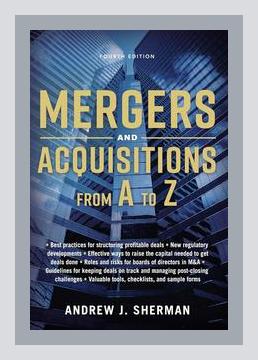Business StrategyMergers and Acquisitions
Andrew J. Sherman’s “Mergers and Acquisitions from A to Z” provides a comprehensive guide to the complex world of mergers and acquisitions (M&A). With insights drawn from his extensive experience, Sherman covers the entire lifecycle of an M&A transaction, from strategizing and planning to execution and integration. The book is structured to offer both theoretical understanding and practical tools for navigating M&A, catering to business owners, executives, and consultants.
Chapter 1: The Lay of the Land
Key Points:
– Overview of the M&A landscape.
– Types of transactions (mergers, acquisitions, joint ventures).
– Key drivers of M&A activity.
Examples:
– The AOL and Time Warner merger as a cautionary tale of poor strategic fit.
– Cisco Systems’ acquisition strategy as an example of successful M&A activities aimed at technological gains and market penetration.
Actionable Step:
– Assess Fit and Strategic Alignment: Conduct a comprehensive review of potential targets to ensure they align strategically with your company’s goals. This includes understanding the cultural, operational, and financial aspects of the target company.
Chapter 2: Getting Your House in Order
Key Points:
– Importance of internal preparedness before pursuing M&A.
– Internal audits and due diligence to ensure the company’s readiness.
Examples:
– A detailed checklist for internal audits that cover financial health, legal matters, and operational capabilities.
Actionable Step:
– Conduct a Pre-M&A Internal Audit: Regularly audit your company’s finances, legal standings, and operations to identify any weaknesses or areas needing improvement before starting the M&A process.
Chapter 3: Developing a Growth Strategy
Key Points:
– Strategies to identify and pursue M&A opportunities.
– The importance of a well-defined M&A strategy linked to overall business objectives.
Examples:
– The example of GE under Jack Welch, who used M&A as a tool to navigate and master different industries.
Actionable Step:
– Align M&A Strategy with Business Goals: Clearly define where M&A fits into your broader company strategy. Are you looking to diversify your product line, enter new markets, or acquire cutting-edge technologies?
Chapter 4: Searching for Candidates and Screening Opportunities
Key Points:
– Methods for identifying potential M&A targets.
– Screening and evaluating potential candidates using appropriate criteria.
Examples:
– Utilizing investment bankers, industry networks, and databases to identify potential acquisitions.
Actionable Step:
– Leverage Networks and Tools: Actively use industry contacts, professional advisors, and databases like Capital IQ or PitchBook to find viable M&A candidates.
Chapter 5: Due Diligence
Key Points:
– Importance and scope of due diligence.
– Key areas of focus including financials, legal, operations, and human resources.
Examples:
– The acquisition of Instagram by Facebook, where thorough due diligence played a crucial role in determining the actual value and fit of the company.
Actionable Step:
– Conduct Comprehensive Due Diligence: Assign a dedicated team to carry out a thorough due diligence process covering all critical areas and using standardized checklists to ensure no aspect is overlooked.
Chapter 6: Valuation and Pricing
Key Points:
– Techniques for valuing a business.
– Negotiating the price and terms of the deal.
Examples:
– Description of various valuation methods such as discounted cash flow analysis, comparables, and precedent transactions.
Actionable Step:
– Use Multiple Valuation Methods: Apply at least three different valuation methods to ensure you have a holistic view of the target company’s worth. This triangulation can prevent overpayment or undervaluation.
Chapter 7: Structuring the Deal
Key Points:
– Different deal structures (asset purchase vs. stock purchase).
– Legal and tax implications of each structure.
Examples:
– Analysis of Google’s acquisition of Motorola Mobility, highlighting the strategic choice of an asset purchase structure for tax benefits.
Actionable Step:
– Choose the Optimal Deal Structure: Work closely with legal and financial advisors to decide whether an asset purchase or a stock purchase is more beneficial based on tax implications and strategic fit.
Chapter 8: Negotiating the Deal
Key Points:
– Strategies and tactics for negotiation.
– Importance of developing a win-win scenario.
Examples:
– Example of Microsoft’s negotiation tactics in their $8.5 billion acquisition of Skype, spotlighting the balance between price and strategic advantage.
Actionable Step:
– Prepare Thoroughly for Negotiations: Equip your negotiation team with detailed insights into both your company’s goals and the target’s strengths and weaknesses. Use role-playing exercises to anticipate various scenarios.
Chapter 9: Closing and Post-Closing Integration
Key Points:
– Steps involved in closing an M&A deal.
– Key elements of post-closing integration.
Examples:
– Detailed post-merger integration plan used by General Electric during its acquisition of Baker Hughes to ensure seamless transition and synergy realization.
Actionable Step:
– Develop a Detailed Integration Plan: Create a comprehensive post-merger integration plan covering key areas such as IT systems, human resources, and cultural integration to ensure smooth operational continuity.
Chapter 10: Avoiding Pitfalls and Ensuring Success
Key Points:
– Common pitfalls in the M&A process.
– Best practices for ensuring long-term success.
Examples:
– Analysis of the Daimler-Chrysler merger, a classic example of cultural mismatch leading to eventual failure.
Actionable Step:
– Learn from Past Mistakes: Regularly review case studies and post-mortem analyses of failed M&A transactions to understand common pitfalls such as cultural misalignment and overestimation of synergies, and plan your actions accordingly.
Conclusion
Andrew J. Sherman’s book is an invaluable resource for anyone involved in the M&A process. Covering the journey from initial strategy to post-integration, Sherman’s insights, real-world examples, and actionable steps provide a clear roadmap for navigating the complexities of M&A. By combining theory with practical advice, the book ensures that readers are well-equipped to execute successful mergers and acquisitions.
